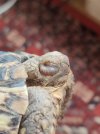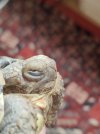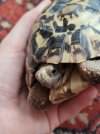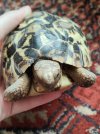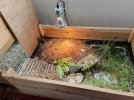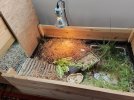Hello again,
Our leopard tortoise seems to have one puffy shut eye. She seemed OK the other day but yesterday I noticed this.
Her other eye looks to be OK and I don't see any swelling or puffyness.
We have bathed her which seemed to help briefly. But this morning she still has her eye shut and it's still quite puffy.
I managed to get some vetarycin eye drops and will see if these help.
I'm not sure what could have caused it, but she does seem to be catching get eye on her shell and rubbing at it.
Any help and advice would be appreciated.
Our leopard tortoise seems to have one puffy shut eye. She seemed OK the other day but yesterday I noticed this.
Her other eye looks to be OK and I don't see any swelling or puffyness.
We have bathed her which seemed to help briefly. But this morning she still has her eye shut and it's still quite puffy.
I managed to get some vetarycin eye drops and will see if these help.
I'm not sure what could have caused it, but she does seem to be catching get eye on her shell and rubbing at it.
Any help and advice would be appreciated.
